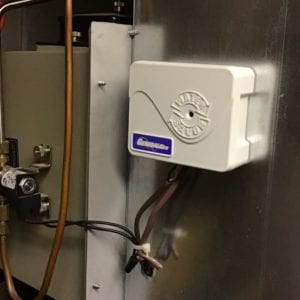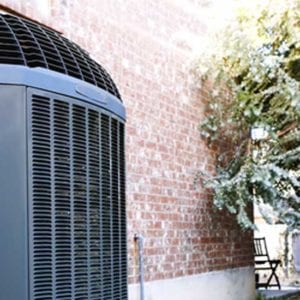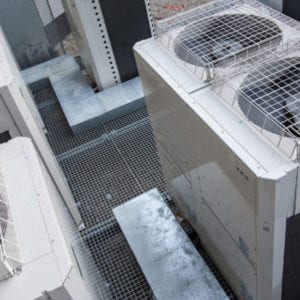How to Easily Make Any Bypass Humidifier More Water-Efficient
Water rates in Ontario are rising even faster than our property taxes. In 2016, the average household water cost was $800 per year – and it’s climbed even higher in the years since.
You’ve fixed leaky faucets, shut down your lawn sprinklers, even tried to cut your showers short – but it hardly makes a dent in your ever-growing utility bills.
You’re not alone if you’re looking for new tactics to reduce your water use.
One of the common sources of water waste is something most homeowners haven’t considered: the humidifier. All humidifiers waste water, and unfortunately, the more convenient whole-home humidifiers tend to be big culprits.
But humidifiers are a lifesaver in our cold Canadian winters, especially when the humidity drops below 35%. Low humidity makes your home feel even colder, and the dry air can wreak havoc on your health and overall level of comfort.
Fortunately, if you own a bypass humidifier, there’s an easy way to drastically increase its water-efficiency and reduce water waste without turning down the humidity level.
Below, we’ll talk about:
- How your humidifier works;
- Why bypass humidifiers waste water;
- How to make your bypass humidifier more water-efficient
1. How Your Humidifier Works
Many people believe their furnace ‘removes’ moisture from the air and a humidifier puts it back. While it’s true that central heat makes your home feel dryer, it isn’t exactly taking moisture away.
Cold air expands as it warms up. If the amount of water vapour remains the same as the temperature rises, the relative humidity in the space drops. Humidifiers counteract this effect by increasing the amount of moisture the air. There are several ways to do this – some humidifiers produce steam, while others draw the air through a moistened ‘vapour pad’.
Humidifiers fall into one of two categories: whole home humidifiers that humidify the entire home and portable humidifiers than humidify the surrounding space. Portable humidifiers are ideal for small spaces (single rooms, dorms or small homes with no central HVAC system) but whole home humidification is significantly more convenient in the long-term because:
- A home humidifier controls the humidity in the entire home at once.
- You don’t have to continually refill it with water.
- It’s quieter and less obtrusive than a portable humidifier.
Some whole-home humidifier units have a built-in fan (like the Lennox HCWP3-18 Humidifier) while bypass humidifiers like the GeneralAire Legacy 1099 Bypass Humidifier work off your forced air furnace’s blower fan.
2. Why Bypass Humidifiers Waste Water
Bypass humidifiers are ultra-quiet and highly efficient, but they have one drawback: water waste.
Some humidity is lost as the air travels through your central heating and cooling system before it reaches your living space. Water also drains off the unit’s water-soaked vapour pad. Most humidifiers include a drain line that carries this excess water into the sewer.
Exactly how much water a humidifier uses depends on:
- How long the humidifier runs
- How much air passes over the vapour pad
- Chosen humidity setting (and how far it the desired humidity is from the baseline humidity in your home)
- What is installed in the water line
That’s assuming your humidifier doesn’t have a leak. Just like a leaking toilet tank, a poorly-maintained humidifier can waste thousands more litres of water each year. If you suspect your humidifier is leaking, it’s time for a service call.
Modern humidifiers are far more efficient than their predecessors (using less water per day than washing a single load of laundry in a high-efficiency washing machine.) Still, all whole-house humidifiers waste at least some water while they run.
You want to reduce that waste as much as possible.
3. How to Make Your Bypass Humidifier More Water Efficient
Several years ago, one of the top manufacturers in the humidifier space decided to do something about water waste.
To date, their product remains one of the only devices on the market to effectively limit waste water in your humidifier.
The solution is simple: when the humidifier receives a call for water, the device automatically switches on and limits water supply to the vapour pad. The humidifier releases only the amount of water needed to keep the pad moist – no more and no less – so less water ends up down the drain.
Simple as it is, the WaterSavor™ is proven to cut water waste by a minimum of 50%. That’s using the default settings. If you fine-tune the settings to a specific humidifier model, settings and season, it’s possible to achieve savings up to 96%.
Most importantly, the WaterSavor™ doesn’t affect your humidifier’s output.
Keep Your Humidifier in Top Working Condition
Like all parts of your heating and cooling system, a whole-home humidifier requires proper care and good maintenance to perform at its best. Regular service is also important to avoid costly humidifier leaks – which can trickle away for months or years before it’s discovered.
Homeowners in the Greater Toronto Area can contact us 24/7 to schedule service for any type of humidifier, from drum-style humidifiers to flow-through bypass humidifiers and more.
You can also reach out to learn whether a WaterSavor™ is right for your humidifier.



